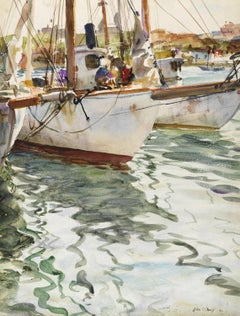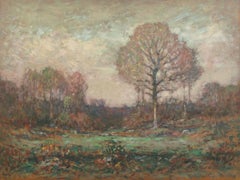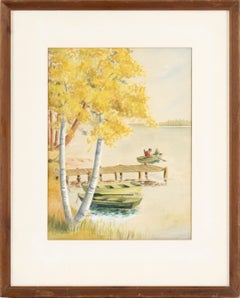Grenning Gallery Art
to
2
1
1
1
1
1
Overall Height
to
Overall Width
to
2
1
1
1
1
2
859
1
1
1
2
1
1
1
1
Period: 20th Century
Fishing Boats I
By John Whorf
Located in Sag Harbor, NY
John Whorf was one of the most accomplished and esteemed watercolorists of the first half of the twentieth century. Creating realist depictions of urban and rural imagery, he worked ...
Category
1940s American Impressionist Landscape Drawings and Watercolors
Materials
Watercolor
"Oak in Spring" 1930 American Impressionist oil painting, oak tree landscape
By Henry Cooke White
Located in Sag Harbor, NY
"Oak in Spring" is a 1930 American Impressionist oil painting of an oak tree landscape.
Painted en plein-air, in an almost pointillist style, H.C. White depicts a classic Connecticut landscape. A Tall wiry tree stands as the focal point, having just bloomed its first leaves; foliage still thin enough to outline every single branch. Reds and browns scattered throughout the foreground connote autumn leaves that had yet to be cleared.
Henry Cooke White (b. 1861) in Hartford Connecticut. His career in art was founded at the age of 14, when he met the famous American Tonalist painter, Dwight William Tyron. The two became lifelong friends, and White even wrote Tyron’s major biography, The Life and Art of Dwight William Tyron (pub. 1930). In the late 1880’s, Tyron pushed White to move to New York City to further his artistic training at the Art Students League. During this time, White studied under many talented artist’s; Kenyon Cox, John H. Twatchman, and William Merritt Chase.
From 1896-1897, White spent time travelling in Europe. Upon his return to the states, he began to spend most of his time in Connecticut, following his favorite painting seasons. Spring in Hartford was followed a week later by spring in Old Lyme, and then finally at Waterford. He’d experience his favorite seasons three times over each year. Once immersed into Connecticut’s community, White was encouraged to paint habitually in Old Lyme; where an art colony was developing, beginning in the spring of 1903.
Inspired by European artists, including Claude Monet, and Pierre Auguste-Renoir, the Old Lyme Art Colony defined American Impressionism by memorializing the serene qualities of rural New England life through use of vibrant palettes and broken strokes on wood and canvas. The Colony comprised upwards of 200 artists during its three decades of creating nature-based scenes in oils and pastels; Frederick Childe Hassam...
Category
Mid-20th Century American Impressionist Landscape Paintings
Materials
Canvas, Oil
Related Items
"Winter Storm, NYC"
By Johann Berthelsen, 1883-1972
Located in Lambertville, NJ
Jim’s of Lambertville Fine Art Gallery is proud to offer this piece by Johann Berthelsen (1883 – 1972).
Born in 1883 in Denmark to artistically inclined parents, Johann Berthelsen would become a widely successful singer, teacher, and painter. After his parents divorced, his mother brought Berthelsen and his siblings with her to the United States in 1890, eventually settling in Wisconsin.
At eighteen, Berthelsen moved to Chicago in the hope of becoming an actor, but a friend at the Chicago Musical College convinced him to audition at his school. Berthelsen received a full scholarship and enrolled at the college, where he was awarded the Gold Medal twice. After graduating, he had an active career traveling across the United States and Canada performing in operas and concerts, before joining the voice faculty at his alma mater in 1910. In 1913, Berthelsen became the voice department director at the Indianapolis Conservatory of Music.
While in Chicago, Berthelsen met the landscape painter, Svend Svendsen...
Category
20th Century American Impressionist Landscape Paintings
Materials
Oil, Canvas
Rowboat Outing - Fall Landscape with Rowboats in Watercolor on Paper
Located in Soquel, CA
Rowboat Outing - Fall Landscape with Rowboats in Watercolor on Paper
Serene lakeside landscape by an unknown artist (20th Century). Two birch trees with bright yellow leaves are gro...
Category
Mid-20th Century American Impressionist Landscape Drawings and Watercolors
Materials
Paper, Watercolor
H 29.5 in W 23.5 in D 0.75 in
Landscape View With Cows Drinking Water by American Artist Hugo Anton Fisher
Located in Stockholm, SE
American artist Hugo Anton Fisher was primarily known for painting landscapes in watercolor. He was born into a family of artists in Kladno, Bohemia....
Category
Late 19th Century American Impressionist Animal Drawings and Watercolors
Materials
Watercolor, Paper
Free Shipping
H 11.42 in W 17.52 in
"The Neighbors"
By George William Sotter
Located in Lambertville, NJ
Jim’s of Lambertville is proud to offer this artwork.
Signed lower right and is Illustrated in the Ashley John Gallery catalog titled "The Pennsylvania Impressionists".
George William Sotter (1879 - 1953)
Born in Pittsburgh on September 25, 1879, Sotter began his art education with local teachers and with Henry G. Keller, who had studied in various German academies. Keller, known for his superb, atmospheric watercolors, taught at the Cleveland School of Art but Sotter studied with him in Pittsburgh. Later Sotter would exhibit between 1903 and 1937 at the Pennsylvania Academy of the Fine Arts. His works were also shown at the Corcoran Gallery (1912-23), the Carnegie International (1901-26), the National Academy of Design (1913 and 1921), and at the Art Institute of Chicago (1911-27). In 1915, Sotter exhibited four works at the Panama-Pacific International Exposition in San Francisco, where he won a silver medal. Sotter was known mainly as a stained-glass artist; his work may be seen from New York City to Salt Lake City. Around a dozen craftsmen worked under him for these commissions.
Sotter spent the summer of 1902 with Pennsylvania impressionist Edward Redfield in Boothbay Harbor, Maine. Between 1910 and 1919, Sotter taught at the Carnegie Institute of Technology. His paintings often feature large areas of sky filled with clouds and he frequently painted winter night scenes, such as Moonlight, Bucks County (Beacon Hill Fine Art), a perfectly successful depiction of a quiet, moonlit landscape filled with twinkling stars. Star-studded skies, although rare in landscape painting, go back at least to 1600 when they appear in the oeuvre of Adam Elsheimer...
Category
20th Century American Impressionist Paintings
Materials
Oil, Canvas
"In Port"
By Edward Willis Redfield
Located in Lambertville, NJ
Jim’s of Lambertville is proud to offer this artwork by:
Edward Willis Redfield (1869 - 1965)
Edward W. Redfield was born in Bridgeville, Delaware, moving to Philadelphia as a young child. Determined to be an artist from an early age, he studied at the Spring Garden Institute and the Franklin Institute before entering the Pennsylvania Academy from 1887 to 1889, where he studied under Thomas Anshutz, James Kelly, and Thomas Hovenden. Along with his friend and fellow artist, Robert Henri, he traveled abroad in 1889 and studied at the Academie Julian in Paris under William Bouguereau and Tony Robert-Fleury. While in France, Redfield met Elise Deligant, the daughter of an innkeeper, and married in London in 1893.
Upon his return to the United States, Redfield and his wife settled in Glenside, Pennsylvania. He remained there until 1898, at which time he moved his family to Center Bridge, a town several miles north of New Hope along the Delaware River. Redfield painted prolifically in the 1890s but it was not until the beginning of the twentieth century that he would develop the bold impressionist style that defined his career. As Redfield’s international reputation spread, many young artists gravitated to New Hope as he was a great inspiration and an iconic role model. Edward Redfield remained in Center Bridge throughout his long life, fathering his six children there.
Around 1905 and 1906, Redfield’s style was coming into its own, employing thick vigorous brush strokes tightly woven and layered with a multitude of colors. These large plein-air canvases define the essence of Pennsylvania Impressionism. By 1907, Redfield had perfected his craft and, from this point forward, was creating some of his finest work.
Redfield would once again return to France where he painted a small but important body of work between 1907 and 1908. While there, he received an Honorable Mention from the Paris Salon for one of these canvases. In 1910 he was awarded a Gold Medal at the prestigious Buenos Aires Exposition and at the Panama-Pacific Exposition of 1915 in San Francisco, an entire gallery was dedicated for twenty-one of his paintings.
Since Redfield painted for Exhibition with the intent to win medals, his best effort often went into his larger paintings. Although he also painted many fine smaller pictures, virtually all of his works were of major award-winning canvas sizes of 38x50 or 50x56 inches. If one were to assign a period of Redfield’s work that was representative of his “best period”, it would have to be from 1907 to 1925. Although he was capable of creating masterpieces though the late 1940s, his style fully matured by 1907 and most work from then through the early twenties was of consistently high quality. In the later 1920s and through the 1930s and 1940s, he was like most other great artists, creating some paintings that were superb examples and others that were of more ordinary quality.
Redfield earned an international reputation at a young age, known for accurately recording nature with his canvases and painting virtually all of his work outdoors; Redfield was one of a rare breed. He was regarded as the pioneer of impressionist winter landscape painting in America, having few if any equals. Redfield spent summers in Maine, first at Boothbay Harbor and beginning in the 1920s, on Monhegan Island. There he painted colorful marine and coastal scenes as well as the island’s landscape and fishing shacks. He remained active painting and making Windsor style furniture...
Category
Early 1900s American Impressionist Landscape Paintings
Materials
Canvas, Oil
"Forest Strongholds"
By John F. Carlson
Located in Lambertville, NJ
Signed lower right. Complemented by a hand carved and gilt frame.
Exhibited at the National Academy of Design, 1928
Category
20th Century American Impressionist Landscape Paintings
Materials
Canvas, Oil
"Road to Argus"
By Walter Emerson Baum
Located in Lambertville, NJ
Jim’s of Lambertville Fine Art Gallery is proud to offer this piece by Walter Emerson Baum (1884 - 1956).
Born in Sellersville, Pennsylvania, Walter Baum was one of the only members...
Category
1930s American Impressionist Landscape Paintings
Materials
Oil, Canvas
"The Canal"
By Edward Willis Redfield
Located in Lambertville, NJ
Jim’s of Lambertville is proud to offer this artwork.
Signed lower left. Complemented by a hand carved and gilt frame.
Illustrated in "Edward Redfield: Just Values and Fine Seeing" by Constance Kimmerle and the Pennsylvania Academy of the Fine Arts's Exhibition of Paintings by Edward Redfield (April 17 to May 16, 1909) brochure
Edward Willis Redfield (1869 - 1965)
Edward W. Redfield was born in Bridgeville, Delaware, moving to Philadelphia as a young child. Determined to be an artist from an early age, he studied at the Spring Garden Institute and the Franklin Institute before entering the Pennsylvania Academy from 1887 to 1889, where he studied under Thomas Anshutz, James Kelly, and Thomas Hovenden. Along with his friend and fellow artist, Robert Henri, he traveled abroad in 1889 and studied at the Academie Julian in Paris under William Bouguereau and Tony Robert-Fleury. While in France, Redfield met Elise Deligant, the daughter of an innkeeper, and married in London in 1893.
Upon his return to the United States, Redfield and his wife settled in Glenside, Pennsylvania. He remained there until 1898, at which time he moved his family to Center Bridge, a town several miles north of New Hope along the Delaware River. Redfield painted prolifically in the 1890s but it was not until the beginning of the twentieth century that he would develop the bold impressionist style that defined his career. As Redfield’s international reputation spread, many young artists gravitated to New Hope as he was a great inspiration and an iconic role model. Edward Redfield remained in Center Bridge throughout his long life, fathering his six children there.
Around 1905 and 1906, Redfield’s style was coming into its own, employing thick vigorous brush strokes tightly woven and layered with a multitude of colors. These large plein-air canvases define the essence of Pennsylvania Impressionism. By 1907, Redfield had perfected his craft and, from this point forward, was creating some of his finest work.
Redfield would once again return to France where he painted a small but important body of work between 1907 and 1908. While there, he received an Honorable Mention from the Paris Salon for one of these canvases. In 1910 he was awarded a Gold Medal at the prestigious Buenos Aires Exposition and at the Panama-Pacific Exposition of 1915 in San Francisco, an entire gallery was dedicated for twenty-one of his paintings.
Since Redfield painted for Exhibition with the intent to win medals, his best effort often went into his larger paintings. Although he also painted many fine smaller pictures, virtually all of his works were of major award-winning canvas sizes of 38x50 or 50x56 inches. If one were to assign a period of Redfield’s work that was representative of his “best period”, it would have to be from 1907 to 1925. Although he was capable of creating masterpieces though the late 1940s, his style fully matured by 1907 and most work from then through the early twenties was of consistently high quality. In the later 1920s and through the 1930s and 1940s, he was like most other great artists, creating some paintings that were superb examples and others that were of more ordinary quality.
Redfield earned an international reputation at a young age, known for accurately recording nature with his canvases and painting virtually all of his work outdoors; Redfield was one of a rare breed. He was regarded as the pioneer of impressionist winter landscape painting in America, having few if any equals. Redfield spent summers in Maine, first at Boothbay Harbor and beginning in the 1920s, on Monhegan Island. There he painted colorful marine and coastal scenes as well as the island’s landscape and fishing shacks. He remained active painting and making Windsor style furniture...
Category
Early 1900s American Impressionist Landscape Paintings
Materials
Canvas, Oil
"The Auction"
By Robert Spencer
Located in Lambertville, NJ
Jim’s of Lambertville is proud to offer this artwork by:
Robert Spencer (1879 - 1931)
One of the rarest and most important artists among the New Hope School, Robert Spencer was bor...
Category
1910s American Impressionist Landscape Paintings
Materials
Oil, Canvas
"Park Street Church, Boston, " John Whorf Impressionist Watercolor WPA Cityscape
By John Whorf
Located in New York, NY
John Whorf (1903 - 1959)
Park Street Church, Boston, circa 1930-45
Watercolor on paper
21 x 15 inches
Signed lower right
Housed in its original frame
Provenance:
Milch Gallery, New ...
Category
1930s American Impressionist Landscape Drawings and Watercolors
Materials
Watercolor, Paper
STREET ACAPULCO
By Joseph Pennell
Located in Santa Monica, CA
JOSEPH PENNELL (1857 - 1926)
STREET ACAPULCO 1901-08. Color pastel and gouache drawing on blue paper. Signed and titled in pencil in his early signature. Image, 10 x 14 inches to j...
Category
Early 1900s American Impressionist Landscape Drawings and Watercolors
Materials
Pastel, Mixed Media, Gouache
Winter Moonlight
By George William Sotter
Located in Lambertville, NJ
signed lower right
Category
1910s American Impressionist Landscape Paintings
Materials
Canvas, Oil



